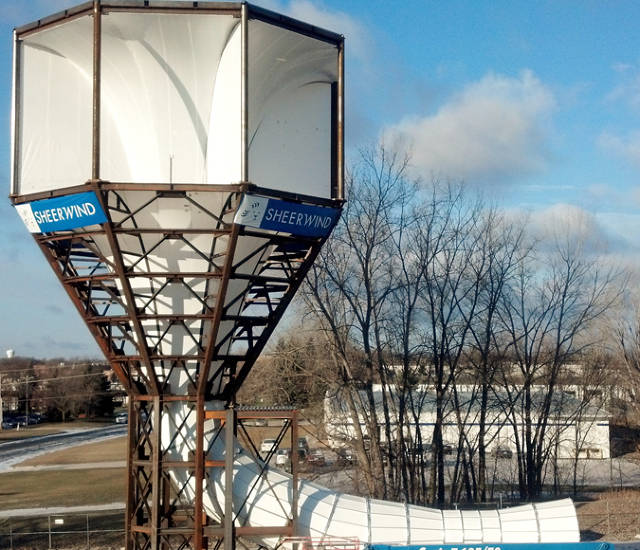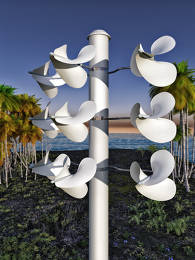This Strange Looking Funnel May Be The Future Of Wind Power (Or Not)
The people behind the Invelox turbine claim that it can take a small gust of wind and make it much bigger. If they’re right, it could change the equation of renewable power.
Daryoush Allaei thinks the wind power industry has it all wrong. Rather than turbines high in the sky, he says, it should bring wind to the ground, in concentrated form. "This is the right track. The industry has been on the wrong track."
Allaei’s Invelox "wind delivery system" is a big funnel that captures air at the top, and squeezes it through a turbine at the bottom. Wind entering at 10 MPH ends up as fast as 40 MPH, he says--meaning it’s no longer necessary to go to a hilltop for optimum conditions.

According to SheerWind--the company Allaei heads--the funnel can produce 600% more power than a conventional wind device, and with lower installation and maintenance costs.
Now, if that sounds too good to be true, there are reasons for skepticism. For one, Allaei is quite coy about exactly what happens inside the funnel: the combination of ducts and pipework is a "trade secret." For another, the system is yet to be tested outside a select group.
Still, Allaei insists the idea is based on proven science--notably the Venturi Effect, which says that wind (and water) speeds into a jet when constrained to a tighter space.
Also, concentrating energy follows the example of other forms of power.
"The reason fossil fuels are cheap now is because the source of energy has been concentrated for millions of years," he says. "The solar guys found out if you use mirrors and lens to concentrate the source, you can improve the capacity. Wind is the only one that has been on a track of concentrating equipment, but not concentrating the source."
"The reason fossil fuels are cheap now is because the source of energy has been concentrated for millions of years," he says. "The solar guys found out if you use mirrors and lens to concentrate the source, you can improve the capacity. Wind is the only one that has been on a track of concentrating equipment, but not concentrating the source."

The latest version of the Invelox is 60 feet high and about 6.5 feet in diameter. Allaei says one advantage is that it can be more or less any size: from something that might power your cellphone, to something the size of today’s utility installation. He reckons we’ll see the first working applications in three to four years--in communities, industrial parks, universities and schools--given more investment.
"We are past the technology validation. The question is more about the business. Can we bring the cost down and compete with a well established industry?"
That might be a daunting prospect. But he points to $2 million in funding so far, and that three of the five largest turbine manufacturers have looked over the technology.
"There is nothing new about an industry going on a track for many years and all of a sudden someone comes along with a different idea, and it changes," he says. "We are telling the industry it needs to retool."
No comments:
Post a Comment